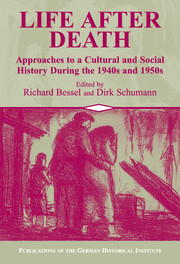Book contents
- Frontmatter
- Introduction Violence, Normality, and the Construction of Postwar Europe
- 1 Post-Traumatic Stress Disorder and World War II
- 2 Between Pain and Silence
- 3 Paths of Normalization after the Persecution of the Jews
- 4 Trauma, Memory, and Motherhood
- 5 Memory and the Narrative of Rape in Budapest and Vienna in 1945
- 6 “Going Home”
- 7 Desperately Seeking Normality
- 8 Family Life and “Normality” in Postwar British Culture
- 9 Continuities and Discontinuities of Consumer Mentality in West Germany in the 1950s
- 10 “Strengthened and Purified Through Ordeal by Fire”
- 11 The Nationalization of Victimhood
- 12 Italy after Fascism
- 13 The Politics of Post-Fascist Aesthetics
- 14 Dissonance, Normality, and the Historical Method
- Index
3 - Paths of Normalization after the Persecution of the Jews
The Netherlands, France, and West Germany in the 1950s
Published online by Cambridge University Press: 05 January 2013
- Frontmatter
- Introduction Violence, Normality, and the Construction of Postwar Europe
- 1 Post-Traumatic Stress Disorder and World War II
- 2 Between Pain and Silence
- 3 Paths of Normalization after the Persecution of the Jews
- 4 Trauma, Memory, and Motherhood
- 5 Memory and the Narrative of Rape in Budapest and Vienna in 1945
- 6 “Going Home”
- 7 Desperately Seeking Normality
- 8 Family Life and “Normality” in Postwar British Culture
- 9 Continuities and Discontinuities of Consumer Mentality in West Germany in the 1950s
- 10 “Strengthened and Purified Through Ordeal by Fire”
- 11 The Nationalization of Victimhood
- 12 Italy after Fascism
- 13 The Politics of Post-Fascist Aesthetics
- 14 Dissonance, Normality, and the Historical Method
- Index
Summary
In the conclusion to his book Fallen Soldiers, George Mosse discusses the difference between World Wars I and II. World War I was still a soldiers' war. Even though many families lost their conscripted sons, they died as soldiers in the trenches, relatively far removed from the home front. World War II was much more a civilians' war, “a different kind of war that would blur the distinction between the front line and the home front.” The violence of World War II was not only massive but also omnipresent. It pervaded all circles of society and made itself felt even in the remotest corners of the nations involved.
At least in the Western European context, the clearest instance of this all-pervasive violence is the persecution of Jews. It would be a mistake to restrict the episode of anti-Jewish violence to the industrial killing by the Einsatzgruppen and in the death camps in Eastern Europe. Not only did the violence begin much earlier than the first operations of Einsatzgruppen in the summer of 1941, it also extended far further west. German Jews were already victimized in the second half of the 1930s, while other Western European Jews experienced a potential threat, and sometimes even actual aggression, when the anti-Jewish climate also overtook other countries. At the end of the 1930s, Jews in Belgium, France, and the Netherlands were confronted with social exclusion, verbal aggression, and in some cases even physical violence.
- Type
- Chapter
- Information
- Life after DeathApproaches to a Cultural and Social History of Europe During the 1940s and 1950s, pp. 65 - 92Publisher: Cambridge University PressPrint publication year: 2003
- 9
- Cited by



